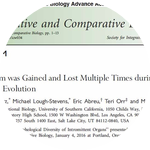About This Project
Most mammals have penis bones, also called bacula. Our recent review indicated that penis bones evolved 9 independent times. Based on this study, the origin of a rodent penis bone is separate from the origin in carnivores. This got us thinking, do these independent events utilize the same set of genes to develop penis bones? In this project we will investigate the expression of a critical bone development gene across species that evolved bacula independently.
Ask the Scientists
Join The DiscussionWhat is the context of this research?
After our review which supported that penis bones evolved independently, our focus turned to understanding the molecular mechanisms involved in these independent derivations. Previous research indicates that both the penis itself and bones evolved long before the most recent common ancestor of mammals. The genes involved in the initiation of these structures have been maintained over time. This leads us to believe that the expression of a conserved set of bone-related genes may be modified in different mammal groups leading to the independent gains and losses of bacula; almost like turning on or off a light switch. Here, we plan to address this by investigating the regulation of a key skeletal gene(Sox9) which is involved in the early development of bones.
What is the significance of this project?
Much of what we know about skeletal evolution pertains to changes in morphology, leaving a giant void in comparing the mechanisms for how new bones evolve. The numerous independent gains of penis bones provides us with a unique model for understanding how new bones can form. Bones are known to develop either from a cartilaginous precursor (endochondral ossification) or directly into bone cells (membranous ossification). Studies on the development of penis bones show that they generally form via a cartilaginous precursor, similar to how long bones like femurs develop. Given these developmental similarities studying penis bones may allow us to learn different regulatory mechanisms not yet identified in other parts of the skeleton.
What are the goals of the project?
We will see if Sox9, a key gene for early cartilage development, is expressed in the developing penises of three mammal species; mice, ferrets, and rabbits. While mice and ferrets have penis bones, rabbits do not. According to our study, mice and ferrets evolved penis bones independently. To start, we will look for Sox9 expression in the genitalia of developing mice using In Situ Hybridization. These comparisons will help us address two critical questions: 1) Do independently evolved penis bones utilize Sox9 in early development? 2) Is Sox9 still expressed in species that never develop penis bones? Confirming the presence of Sox9 in the developing genitalia of these three species is the first step in understanding how a key skeletal gene like Sox9 may be regulated in different species.
Budget
1) By embedding our samples we will be able to cut extremely thin sections of the genitalia, allowing us to visualize regions of the anatomy with better resolution. 2) Glass slides and cover slips are necessary for proper viewing and storage of tissues after they have been thinly sliced. 3) Sox9 RT-PCR Primers allow us to convert the Sox9 RNA extracted from tissues into complementary DNA (cDNA), which can be amplified. 4) The cDNA Cloning Kit provides us with higher fidelity replication of our target gene sequence. 5) DIG RNA Labeling Mix will bind DIG to our target RNA, allowing for the color change reaction in future steps. 6) Anti-DIG Antibodies; these antibodies are conjugated to alkaline phosphatase and will bind to the DIG tag on our target RNA 7&8) Bromo-4-chloro-3-indolyl phosphate & Nitro Blue Tetrazolium react with the anti- DIG antibody resulting in purple coloration of the tissue where our Sox9 RNA is present.
Endorsed by
Meet the Team
Team Bio
Our lab is generally interested in studying sexual selection. Since selection operates on the ability of an individual to pass on genes to subsequent generations, interactions between males and females during sex are important. These interactions lead to the rapid evolution of phenotypes including but not limited to genital morphology, gamete morphology, and gamete signaling. Here is a link to our lab site for more details http://www-bcf.usc.edu/~matthedd/research.html
Nick Schultz
My fascination with comparative anatomy and physiology as an undergrad at USC led me to pursue a my PhD. In 2013 I started a project on the genetics of mouse penis bone morphology which has expanded into a number of interesting projects, which have exposed me to a diverse set of techniques. The thought that drives me the most in my research is that we could potentially learn a great deal about bone development by studying penis bones. I hope that studies like the one proposed here will help to boost support for basic evolutionary research.
Additional Information
Project Backers
- 4Backers
- 12%Funded
- $129Total Donations
- $32.25Average Donation


